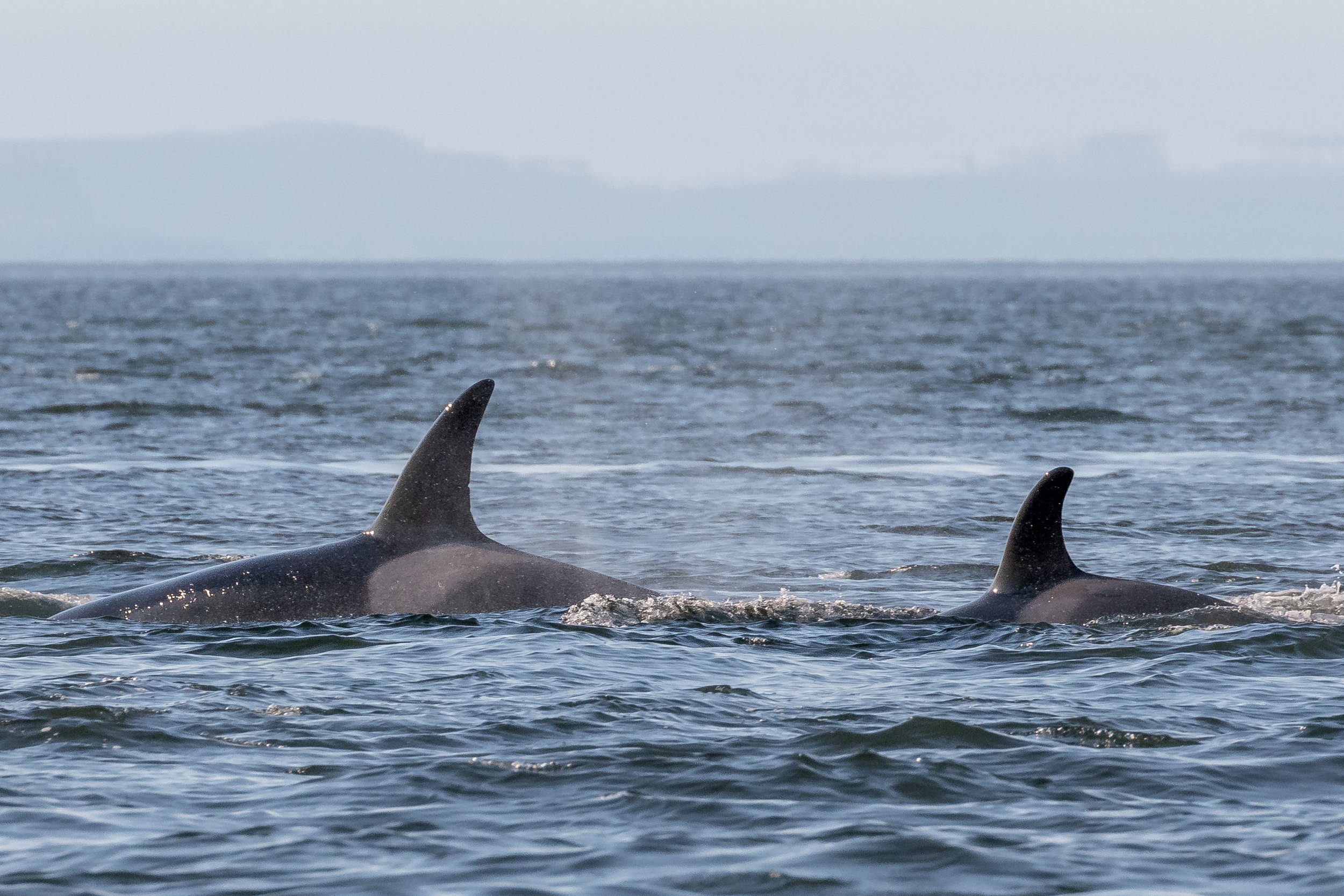September 10, 2022 - A day filled with Orca
With September almost half over our humpbacks are beginning to think about returning to the tropics for the winter. This doesn’t mean whale season is over, far from it! September is always a blast as our now plump humpbacks begin to very slowly move south from the north island and we get to see some of our spring-time favourites again. Today we had Big Mama and her calf, back from their summer up north. The last time we saw Big Mama and her calf was June 29th and we assume they kept travelling north to Big Mama’s preferred feeding grounds near Campbell River. Now that summer has ended they’ve found their way back to our neck of the woods and will spend the next 6 or so weeks slowly making their way back towards the San Juan Islands before heading for Hawaii!
Not too far from Big Mama and her young one was another mom and calf pair - Mammoth and her 2022 calf. Both these pairs were travelling around Gabriola Island, east of Orlebar Point right along the Duke Point ferry route.
One of our staff recently proposed a theory that could explain why we so often find our humpbacks on or near the ferry routes that makes a lot of sense! As ferries and other large ships travel through the water they are turning it up, mixing it and adding oxygen to the waters. This added oxygen is beneficial to small organisms - like phytoplankton and small fish - in the water. These small organisms make a tasty snack for many creatures, including our humpbacks! It’s an interesting theory and it would be cool to see if there really is a correlation between ferries, phytoplankton and fish abundance, and humpback whale feeding - or if it’s all in our heads!
After our time with the two lovely mommas and their kids we travelled across the Strait of Georgia to the southwest side of Bowen Island to find the T100s and T124A4s travelling north.
These 2 pods were spread pretty spread out, so we weren’t even sure if they were travelling together at first, but they seemed to come together and then spread out throughout the day. It’s very possible they were on the hunt and looking for lunch, spreading out to cover more ground before regrouping. This is a common tactic for hunting amongst the Bigg’s orca community. These whales are near silent hunters, which has earned them the nickname “wolves of the sea”. While the Southern Resident orca use echolocation to find their food, Bigg’s orca are stealthy, staying quiet and splitting up to stalk and ambush their prey. Marine mammals have excellent underwater hearing and if the Bigg’s orca were too chatty their food would get spooked and leave the area. In silence the whales split up, searching the waters and when they locate something tasty they are quick to alert their pod and take it down together. We weren’t fortunate enough to witness a hunt during these trips, but we did get to watch Hutchins (T100) and her children Laurel (T100C), Tharaya (T100E), and Estrella (T100F) travelling through the Strait with Sabio (T124A4) and her one-year-old daughter T124A4A.
In the morning this group travelled slowly north and we were able to reacquire them in the afternoon just south of Gibson. The afternoon was pretty similar to the morning, with the pods separating and merging, but we did get to see a bit of tail lobbing and a few spy hops which is always exciting.
Enjoy the photos from the trips taken by marine naturalists Aly Kohlman and Vanessa Vereschahen.
Big Mama (BCY0324). Photo by Aly Kohlman, 10:30AM tour.
Big Mama (BCY0324)’s 2022 calf. Photo by Aly Kohlman, 10:30AM tour.
Big Mama (BCY0324). Photo by Aly Kohlman, 10:30AM tour.
Big Mama (BCY0324). Photo by Aly Kohlman, 10:30AM tour.
Mammoth (KEX0023). Photo by Vanessa Vereschahen, 10:30AM tour.
Mammoth (KEX0023)’s 2022 calf. Photo by Vanessa Vereschahen, 10:30AM tour.
Estrella (T100F). Photo by Aly Kohlman, 10:30AM tour.
Front to back: Hutchins (T100) and Estrella (T100F). Photo by Aly Kohlman, 10:30AM tour.
Hutchins (T100). Photo by Aly Kohlman, 10:30AM tour.
Hutchins (T100). Photo by Aly Kohlman, 10:30AM tour.
Hutchins (T100). Photo by Aly Kohlman, 10:30AM tour.
Front to back: Hutchins (T100) and Estrella (T100F). Photo by Aly Kohlman, 10:30AM tour.
Front to back: Hutchins (T100) and Estrella (T100F). Photo by Aly Kohlman, 10:30AM tour.
Laurel (T100C). Photo by Aly Kohlman, 3:30PM tour.
Left to right: Sabio (T124A4) and T124A4A. Photo by Aly Kohlman, 3:30PM tour.
Laurel (T100C). Photo by Aly Kohlman, 3:30PM tour.
Family photo! Left to right: Laurel (T100C), Hutchins (T100), Estrella (T100F) and Tharaya (T100E). Photo by Aly Kohlman, 3:30PM tour.
Left to right: Sabio (T124A4), Hutchins (T100), and T124A4A. Photo by Aly Kohlman, 3:30PM tour.
Hutchins (T100). Photo by Aly Kohlman, 3:30PM tour.
Hutchins (T100). Photo by Aly Kohlman, 3:30PM tour.
Laurel (T100C). Photo by Aly Kohlman, 3:30PM tour.
Photo by Aly Kohlman, 3:30PM tour.
Photo by Aly Kohlman, 3:30PM tour.
Photo by Aly Kohlman, 3:30PM tour.
Front to back: Estrella (T100F) and Laurel (T100C). Photo by Aly Kohlman, 3:30PM tour.
Front to back: Estrella (T100F) and Laurel (T100C). Photo by Vanessa Vereschahen, 3:30PM tour.
Laurel (T100C). Photo by Vanessa Vereschahen, 3:30PM tour.
Laurel (T100C). Photo by Aly Kohlman, 3:30PM tour.
Photo by Aly Kohlman, 3:30PM tour.
Photo by Aly Kohlman, 3:30PM tour.
Photo by Aly Kohlman, 10:30AM tour.
Shhhh….shhh. Photo by Aly Kohlman, 10:30AM tour.
West Coast landscapes. Photo by Vanessa Vereschahen, 3:30PM tour.
“Seal rock”. Photo by Vanessa Vereschahen, 3:30PM tour.
Smokey sunset. Photo by Vanessa Vereschahen, 3:30PM tour.
Red moonrise. Photo by Vanessa Vereschahen.




































